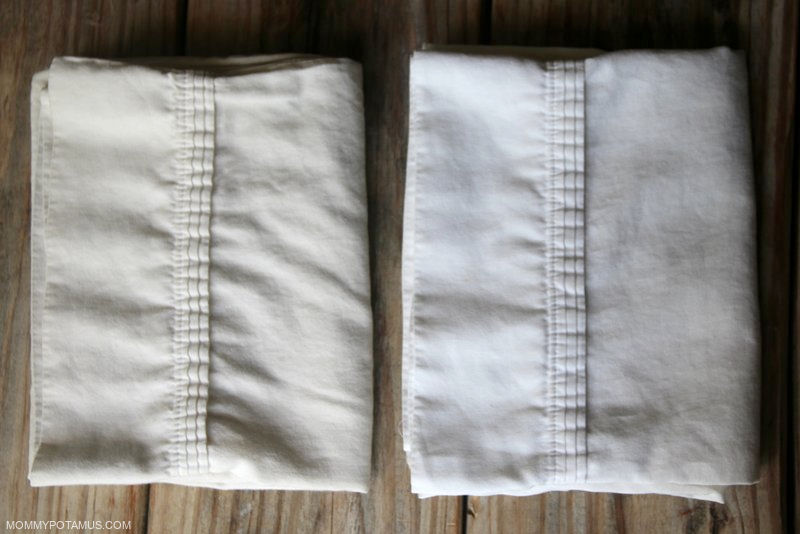
Natural bleach alternative (noun) – Various concoctions that are said to whiten and brighten clothes, but rarely work in real life. See also: Laundry unicorns.
If that’s how you feel after trying a few bleach alternative recipes, I get it. I’ve tested everything from citric acid and lemon juice to vinegar and peroxide to whiten my clothes. Peroxide alone worked beautifully for awhile . . . and then it didn’t. When we moved to a homestead with spring water a few years ago, all my whites started to become dingy. Now, I adore all the lovely minerals in my water – I just don’t want them creating a yellow buildup on my sheets!
Why avoid bleach?
So was I tempted to cave and treat them with bleach? NO! Yes . . yes I was. Here’s the deal, though: As mentioned in this article from certified Building Biology practitioner Andrea Fabry, a study conducted at the University of Leuven in Belgium – which included 9,000 children – concluded that:
Passive exposure to cleaning bleach in the home may have adverse effects on school-age children’s health by increasing the risk of respiratory and other infections. The high frequency of use of disinfecting irritant cleaning products may be of public health concern, also when exposure occurs during childhood.”
I could seriously go on, but the bottom line is this: There are a number of reasons to be concerned about the use of bleach, both in how it affects individuals and the environment. In contrast, the recipe I’m sharing with you contains only three simple ingredients:
- hydrogen peroxide, which breaks down into plain water after the extra oxygen atom is released
- washing soda, which breaks down into soda ash
- lemon essential oil
Finally, something that works!
Alright, back to my predicament with the yellow sheets. After a little research on homemade bleach alternatives, I discovered that the two active ingredients in store-bought oxygen bleaches are nothing more than sodium percarbonate (powdered hydrogen peroxide) and washing soda. Yep, that’s it!
I was already using washing soda in my homemade laundry detergent along with the occasional addition of peroxide, but in order to really have an effect on my whites I found I needed to increase the concentration significantly. This week, while I’m washing sheets, I decided to grab two pillow cases from my attic to show you how well it works. Here’s what they looked like before I put one in a bucket with this homemade bleach alternative – both pretty dingy!
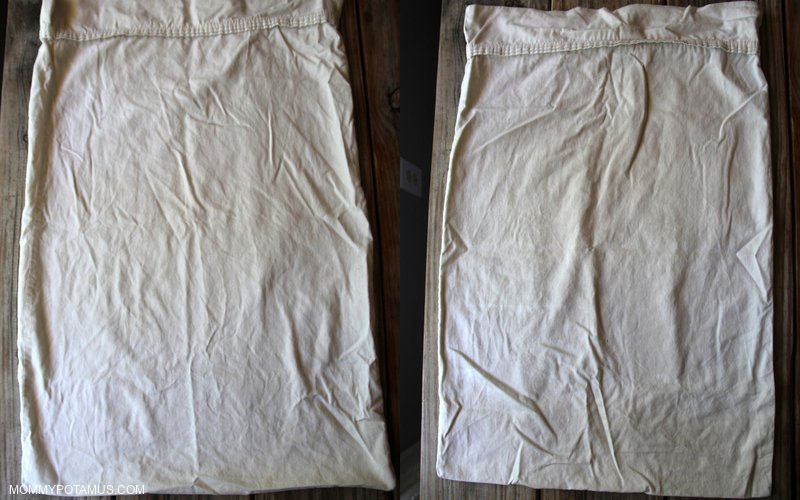
Here’s how different they were after:
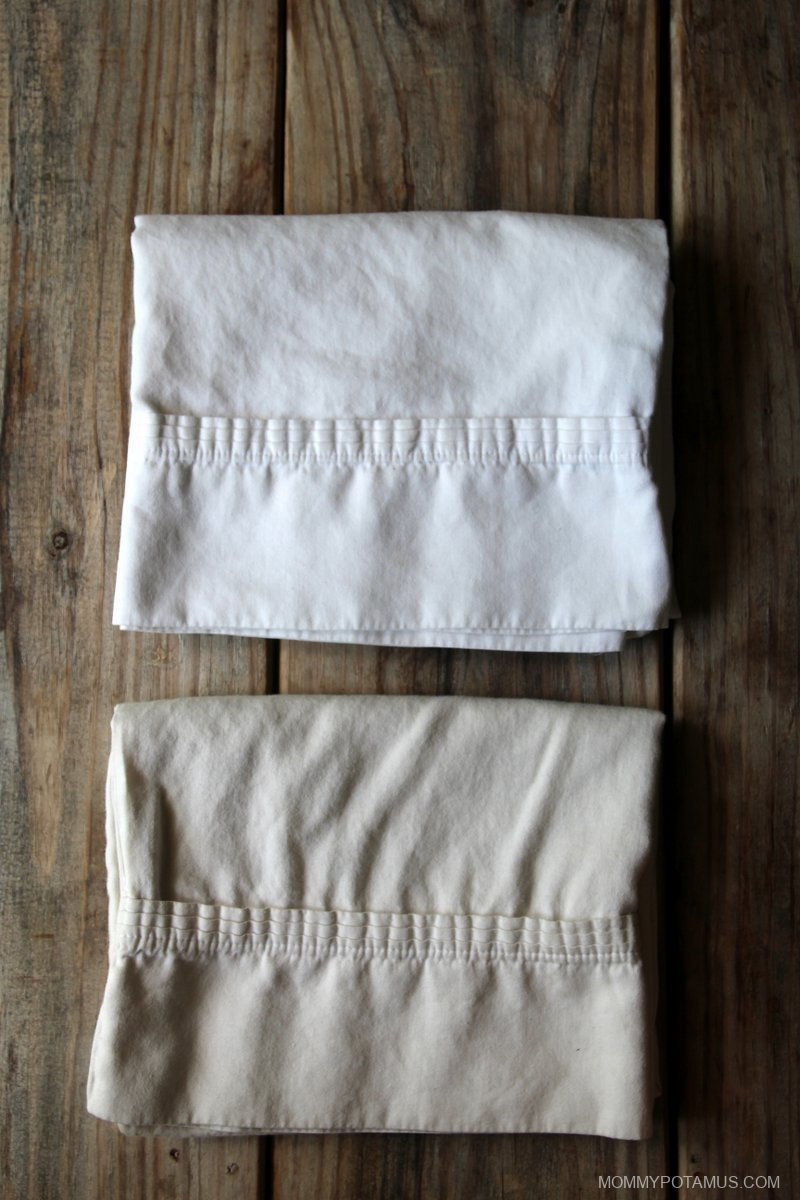

Now, it’s not magic fairy dust. Your whites will not be so bright that they practically glow in the dark and you may need to treat them more than once, but I have had great results with this recipe.
Homemade Bleach Alternative Recipe
Ingredients
- 4 cups hot water (plus additional room temperature water)
- 1 cup washing soda
- 1-2 cups 3% hydrogen peroxide (or 1 cup Pure Sodium Percarbonate, which is powdered hydrogen peroxide bonded with washing soda)
- 10 drops lemon essential oil
- 3-5 gallon bucket or washing machine
Instructions
Soak-In-The-Washing-Machine Method
- If you have a washer that has a "Drain & Spin" setting you can select, I recommend soaking your clothes in this solution, then draining the water and washing your load as usual.
- To do that, add a small load of clothes to the washing machine and choose cool/room temperature water and the "small" setting for your load size.
- While the machine is filling, add the lemon essential oil to the washing soda and stir thoroughly until the drops are well distributed. If you're using powdered sodium percarbonate instead of liquid hydrogen peroxide, add it in as well. Add the washing soda mixture to hot water and stir until it is completely dissolved.
- Once dissolved, add the mixture immediately to the basin. If you're using liquid hydrogen peroxide instead of sodium percarbonate, now is the time to add it to the basin as well.
- Allow the mixture to soak before draining the liquid and washing as usual – I find that overnight is best. If needed, I repeat the process – old, set-in stains sometimes need more time to loosen up.
Bucket Method
- Add the lemon essential oil to washing soda and stir thoroughly until the drops are well distributed. Add the washing soda mixture and sodium percarbonate (if using) to hot water and stir until the washing soda is completely dissolved. If you're using liquid hydrogen peroxide, measure out 1-2 cups in a separate container.
- Pour the hot washing soda mixture into a large bucket (3-5 gallons), then add 14 cups of room temperature water. If you added sodium percarbonate to your washing soda mixture your hydrogen peroxide is already mixed in. If you didn't, now is the time to add 1-2 cups of liquid hydrogen peroxide.
- Place laundry in the bucket and add additional water until the clothes are covered – I usually end up adding about 14 cups. Soak overnight, then wash as normal. If needed, I repeat the process – old, set-in stains sometimes need more time to loosen up.
Notes
Update: Two Non-Toxic Store-Bought Options
When life gets busy and you don’t want to DIY, you don’t have to settle for the toxic stuff. Molly’s Suds Oxygen Whitener and Eco-Me Natural Laundry Whitener Brightener are both very similar to my recipe below.
Frequently Asked Questions
Below are answers to some of the most common questions I’ve received since first posting this tutorial.
Is this bleach alternative colorfast?
Oxygen bleach is considered color safe, but not all clothing is colorfast and therefore may be negatively affected by the bleach alternative. Thanks to my adorable helpers, color clothes (and legos) sometimes make it into a load of whites at my house, and so far it’s been fine.
With that said, I haven’t soaked color clothes for long periods of time in this bleach alternative – only whites. I recommend testing for colorfastness by soaking an inconspicuous part of your clothing item in the mixture before using, and not soaking for long periods of time/overnight.
Your recipe says not to use hot water. Why?
In the instructions below you’ll see that hot water is used to dissolve the washing soda, but mainly room temperature water is used.
I know this is pretty much contrary to everything we’ve been taught, but here’s the deal: Hot water weakens the active ingredient in both hydrogen peroxide and bleach. (2)
Both substances degrade over time with exposure to light/air, and heat accelerates that process. Using room temperature water is going to feel weird, but trust me, it will work out.
I have leftover washing soda. What else can I use it for?
Washing soda is wonderful in a variety of homemade cleaning products, including dishwasher detergent, laundry detergent, and scouring powder.
I have leftover hydrogen peroxide. What else can I do with it?
According to the CDC, 3% hydrogen peroxide (the kind commonly found on store shelves), “is a stable and effective disinfectant when used on inanimate surfaces.” It has to be used properly, though, and in this article I’ll cover what you need to know.
Can you recommend a fabric softener?
While a few fabric softeners get a “B” from the Environmental Working Group, the majority get a “D” or “F” in terms of safety. That’s not the only problem, though – they tend to leave a residue that serves as a breeding ground for mold and mildew. Wool dryer balls are a great alternative that soften and fluff clothes while reducing drying time.
Here’s how to make them and here’s what to buy if you don’t want to DIY.
Something else I’ve found helpful is to add plain white vinegar to a Downy Ball and toss it in with each load of laundry to soften clothes naturally.
Would this also work on tough stains? It seems like half of my kids’ clothes have stains that my homemade detergent does nothing for.
I use this recipe more as a brightener, but it may also help with stains. I do have a stain remover recipe that you could use to pre-treat stains before using this bleach alternative.
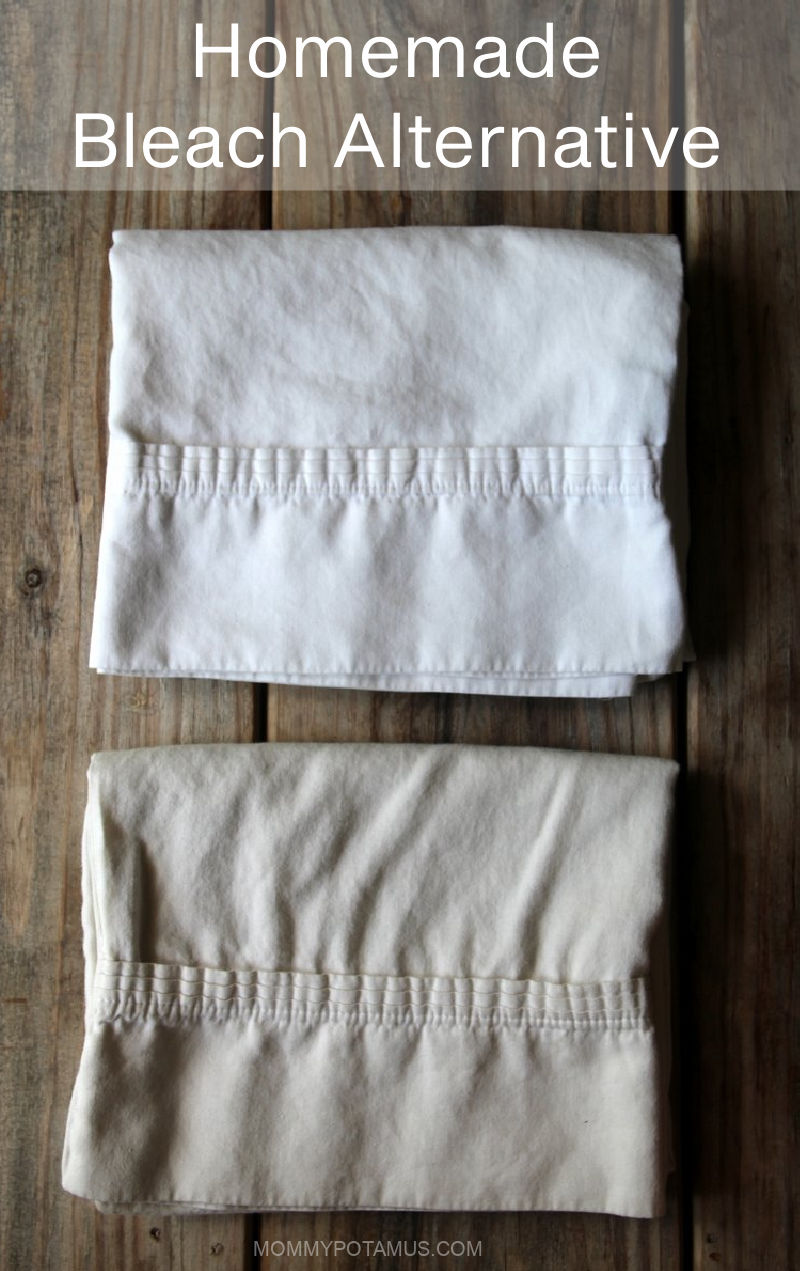
Want a FREE ebook of non-toxic cleaning recipes that WORK?
I’ve created a free ebook for you as a gift for signing up for my newsletter. 7 Non-Toxic Cleaning Recipes That Really Work covers seven recipes that you can make in just a few minutes each for squeaky clean windows, sparkling dinnerware, lemon-fresh countertops, and more. Subscribe to my newsletter below and you’ll be redirected to a download page for immediate access to this PDF ebook.
Sources
1. Science Daily (2015) Passive exposure to bleach at home linked to higher childhood infection rate
2. Hong Kong Government Information Centre. The Use of Bleach

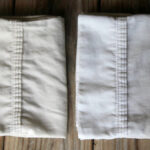
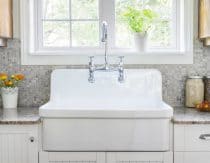

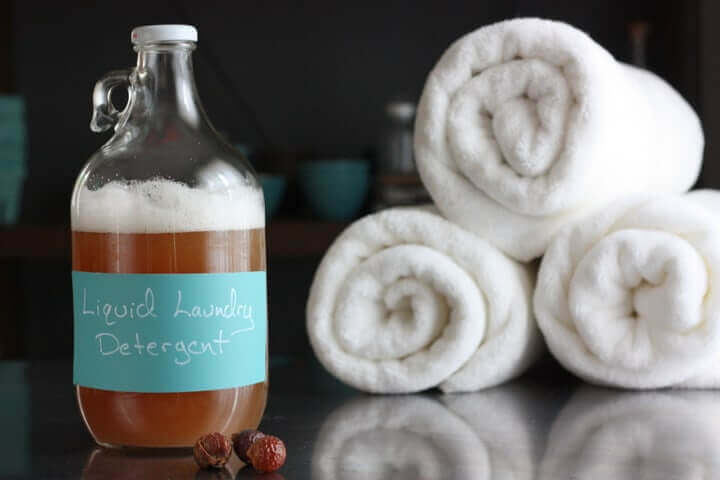

Would borax work as washing soda?
Ofcourse, you can mix baking soda and borax powder with any suitable essential oil.
Borax is not the same as Washing Soda. They are 2 completely different products. Many people do use Borax as an ingredient in dishwasher detergent, but it is often in combination with Washing soda. They are not really replacements for one another. Tho you can make your own decision as to whether to use Borax, Heather states that she has chosen not to use Borax in her dishwasher or laundry detergents.
Hi Heather,
I really want to try this! Thank you for sharing. Very odd question….I have same soap dispenser and mine just broke. Having issues finding model numer. Any way you mind sending me the info?
Thank you,
Laurie
Hi Laurie, what soap dispenser are you talking about?
Wow thanks for sharing this!!! You’ve just changed my life, and saved my clothes! I work for a house keeping business and have been looking for an Alternative to using the potent clorox. Every time I’m done using it I feel Iike the smell is all over me, and for hours after cleaning not to mention that I have ruined so many of my favorite shirts cleaning with the clorox. Can’t wait to try this alternative! Thanks again!
What is washing soda???
https://mommypotamus.com/how-to-make-washing-soda/
My Kroger and Walmart both carry it, it’s in a yellow cereal-like box, by Arm & Hammer, in the laundry section, for about $4. It’s nearly baking soda, but it’s a stronger base, and suited for washing with. She has an article about how to make your own, if you can’t find it in stores.
How well does this work with well water?
Where do you buy your hydrogen peroxide and in what quantity?
Costco. Two quarts for $2.
I use 35% food grade hydrogen peroxide for many things. I would like to know the easiest way to dilute it down to 3% to make this recipe. Thanks.
11 ounces of water to one ounce of 35% food grade hydrogen peroxide will get you 3% strength of HP. There is a book called “The one minute Cure “ by Madison Cavanaugh. On page 80 it tells you how to mix distilled water & HP to obtain 3% solution.
I buy my 35% Food Grade Hydrogen Peroxide online from Pure Health Discounts. I bought 2 gallons.
Would this also work on tough stains? It seems like half of my kids’ clothes have stains that my homemade detergent does nothing for. Do you use a separate recipe for spots of stains?
Thanks!!
Just wanted to clarify the “washing soda” ingredient. Would you be referring to the homemade one that you have on your blog or any general laundry detergent (liquid or powder)? thanks!
Washing Soda is not a “general laundry detergent” or cleaner. It is a specific product. You could use the recipe you refer to from her site, or buy a box of Washing Soda. The most popular one, or one most seen is by Arm and Hammer. I have never tried to make my own. I’ve seen recipes for “making” it several times and places, but I have never been completely satisfied that it really is the same thing. I’ve always bought and used Arm and Hammer Washing soda.
But you will want to use Washing Soda, not laundry detergent (which is different, but that can be made using washing soda as a main ingredient).
Is this different than using oxygen bleach (sodium percarbonate + washing soda)? Or just a DIY version of it?
Would you use this to whiten microfiber diaper inserts? Id love more post on cloth diapers 🙂
Looked on line for dried hydrogen peroxide eand cant find it. Even on Amazon. Help..
She actually didn’t use dried hydrogen peroxide in her recipe, IF that is why you asked.
She used liquid hydrogen peroxide 3% as you find in the pharmacy aisle. IF you have a Sam’s or Cosco you can usually find it at least a little cheaper at those. Otherwise, I’d suggest Walmart (again in the pharmacy section of the store.
Would this be safe to use on stubborn cloth diaper stains? I have the diapers that are cotton birdseye and PUL.
Does this work as a disinfectant like bleach?
Peroxide disinfects as does the lemon essential oil.
Just curious, if using the sodium percarbonate do you still need to add washing soda, since the sodium percarbonate contains washing soda?
I used 1 cup soda and 2 scoops of oxyclean plus my soap and soaked my nieces yellowed diapers overnight! Nearly a miracle. I double rinsed them of course but if yours have become yellowed I would recommend trying it.
Could you use this maybe a couple of times in a row or does it become infective over night?
I have been doing something similar to this (since Walmart stopped carrying “All Free Clear Oxygen Booster”)– a couple TBS of washing soda and about 1/2 c Hydrogen Peroxide, mix it together then toss it in the drum of my front-loader HE machine with the clothes. I use it in the place of the oxygen wash booster. I also mix it in with a little dishpan of water for pre-treating stained clothes. It seems to work ok. I’ve never done a bigger “batch” than that. No idea if my measurements are sufficient or not.
Rachel, Do you do this for white clothes only or does it work well for colored wash too?
Will powder hydrogen peroxide work as well? If so what quantity in the powder version? Many thanks
Yes I’m not sure either about washing soda, being from UK. Is it borax or baking soda perhaps? Been on the hunt for a bleach alternative forever!! Thanks x
Katy, borax and washing soda are not the same product. Borax is also known as sodium borate (borate is a salt of boric acid….the stuff you can make eye washes with)–>washing soda is simply baking soda that has been slightly changed chemically by heating it. MommaP has a great recipe that i use all the time.
Just search for sodium carbonate…I found in 5kg quantities on ebay. Its also used in pool water treatment!
In my opinion, it would be best to add the lemon essential oil at the time you would add the peroxide. Why? Because the constituents in essential oils break down very quickly in hot temperatures, thus getting rid of all the wonderful things for which you use the oil in the first place! Especially with lemon essential oil, you’re not only getting that touch of lemony fresh scent but also a great germ killer too!
Thanks for sharing this! My husband has really been wanting to use bleach on our whites lately, but I just read in The Dirt Cure that kids in homes where bleach is used are 20% more likely to suffer respiratory issues. I’m excited to try this!
Do you know if this could be used for cloth diapers?
You mentioned that you love the minerals in your water. So do you not use water softener? I have, but just ran out and am considering not purchasing any more. I understand those minerals are good for us. But I’ve also heard that hard water can cause build-up within the plumbing pipes. What are your thoughts?
Hi, Our water source is our well and the water is packed with minerals. I can tell you that those minerals make my hair and nails grow faster than any other time in my life but it does tend to make my hair dry and brittle… like straw! In my opinion it’s not a great trade off for the growth.
The minerals are extremely hard on our plumbing and appliances. They build up very rapidly (depending on their concentration) and can cause dishwashers & washing machines to fail and will slow down the water flow through faucets and shower fixtures. We find we need to remove faucet screens & flush our hot water heater every 6 months to remove the build up of the larger mineral particles and our shower curtain turns yellow at the bottom within weeks not to mention the damage done to our clothes over time. I also have to scrub the shower head every week to maintain the water flow in my shower. Not everyone’s well water has mineral content that’s this high but even at lower levels it causes damage.
We have a 4-stage filtering process which helps immeasurably.
I suggest you get your water tested to check the levels of minerals it contains, consult a professional and go from there. Best of luck!
JM
Have you tried sodium percarbonate or commonly called oxygen bleach?
Thanks, I’ll be trying this. I just convinced my husband to give up bleach and he tried lemon juice. I’m just waiting for him to say it’s not good enough. And I already have the additional ingredients!
Could this also work as a bathroom/shower cleaner? We are trying to tackle some mold (naturally) and haven’t found anything that works great.
I’d try some oregano oil and vinegar on the mold. Oregano is fabulous at killing fungus.
Clean first with your preferred detergent, then apply the vinegar/oregano mixture. Rinse after 10+ minutes if the vinegar bugs you.
What ratio do you use with the vinegar and oregano oil?
And Clove & Eucalyptus oils! 🙂
I full-time RV so I have to wash my clothes in a laundromat. I don’t have a wash tub. Any ideas how to incorporate this recipe into my lifestyle?
Have you tried using percarbonate?
Very confused about hot vs. non-hot water. Your recipe says to use hot. The preamble repeats this about the recipe, but then says “but mainly room temperature water is used” and instructs not to use hot. So which is it? Is there any way you can rewrite the instructions so that they are not contradictory? Is it ok to follow the recipe (using hot)?
Thanks!
The smaller amount of hot water in the recipe is used to dissolve the washing soda, then it is cooled down with the cool water (larger amount of cool water) before adding the peroxide (and as someone says on here above, I suggest adding the lemon essential oil at this time as well).
I hope that helps!
Is the essential oil necessary or just for making it smell nice?
It does help break down grime but it’s optional 🙂
My family and I are moving to more natural homemade products. Currently in our laundry we are using BioKleen liquid laundry detergent (we will be trying homemade in the next few months). Additionally, we also use a color safe/whitening bleach and a fabric softener, which I would like to move to homemade. We have tried Molly Suds Dryer Balls and they are great, and we will continue to use, but we are hoping a liquid homemade fabric softener will help soften the clothes a a bit more in addition to the dryer balls. I’ve been doing quite a bit of research into homemade recipes and my family has decided on the following:
Bleach – hydrogen peroxide, lemon juice, essential oil, water
Fabric softener vinegar, baking soda, essential oil
My concern and question is this. I know vinegar and hydrogen peroxide when mixed create peracetic acid. I am unsure of how they would mx in a washer even though one is during the wash cycle and one during the rinse cycle. Should I be concerned? Any other suggestions?
Andrew, omit baking soda and just use vinegar.
I agree with Emily. In addition, white vinegar is an acid and baking soda is a base, so when you mix them together you’re neutralizing both. I add plain white vinegar to a Downy Ball and toss it in with each load – works well as a fabric softener.
I’ve been washing with peroxide in the wash cycle and vinegar in the rinse cycle for a couple of years now and have never noticed a peracetic acid creation. I think because the peroxide used in the wash cycle is pretty well rinsed away before the rinse cycle begins, there won’t be any or enough peroxide to float in the rinse water and mix with the vinegar. Just a guess.
Pls ma’am how do I make a simple bleach or stain removal for all colors. And I want to preserve it for at least 3 months
I have a washing machine that locks till it’s completed. I wouldn’t be able to add anything in between cycles. I can change the temp settings. What do you suggest? Can I just add everything in at one time and let the cycle run thru?
My suggestion would be to mix the hot water and washing soda together till the soda has dissolved in a jar or bucket, etc, and add it to the washer before adding the clothes, then use cold or warm water to fill the machine filling it as usual. (and I’d add the lemon essential oil (which you might put in some cool water in a jar to pour in after you add the clothes, if you can’t have the washer open while it is filling (or if you have a bleach dispenser you might put it in there, as well as the peroxide).
Hope this helps.
Hello…I would like to add the peroxide directly to a large load of wash and wash as normal.
Please tell me how much to add.
Thanks
Jean
Hi there! Thanks so much for this post it’s great! Just wondering if you could use this as a cleaning agent in the bathroom? Our shower recess gets horrible mildew and mould in just one of the bathrooms, I am using natural cleaners but they just aren’t cutting it, I am almost to the point of doing like you said and reverting to chemicals but hate the idea of it!? Any suggestions would be welcome at the moment I use bicarbonate and vinegar as well as Onguard concentrate essential oil cleaner but nothing seems to do the job… TIA for any help!
Could this cleaning mix be used to disinfect cutting boards from raw meat?
Is this solution for one time use or can it be stored and used again?
One time use 🙂
If i use the soak-in-the-washing-machine-overnight method, do I need to drain all of the water first before I begin the wash cycle the next day, or can I just start the wash cycle using the same water that the clothes soaked in overnight? Thanks!
Ok, so I’ve done this a few times now, using the soak water in which I soaked the clothes overnight to also wash the clothes with freshly added water in the washing machine the next day, and they turned out super bright! I’ve tried some other alternative bleach recipes using different measurements mostly of these same ingredients (never before have I tried soaking overnight), but none have resulted in the clothes looking as good as this, as if I had used bleach itself. This is exciting, because I was about to give up and go back to cheating w/ occasional clorox on my husband’s white work shirts, so I really appreciate you sharing this recipe. Thankyou!
I noticed that it’s recommended to make batches as needed due to the breakdown of the hydrogen peroxide, but would it be ok to make batches of the washing soda and lemon essential oil ahead of time? Thanks
Heather, could I Lime essential oil be used instead of lemon essential oil? If not, I would be interested to understand why. Thank you in advance.
I haven’t tried it but I would think so
I can’t see that you answered anyone’s questions about using sodium percarbonate. If I were to use this, how would the recipe change? I have it on-hand and it seems it would be less expensive long-term than using liquid hydrogen peroxide. I realize some products cancel each other out when used simultaneously, so I don’t want to waste time or ingredients.
I have been using baking soda in my clothes with every wash for a long time, mostly to make the clothes smell fresher. My clothes really stay white without having to use a mixture. But I do sort my clothes, also, which helps, I think.
Hydrogen Peroxide is bleach!
Actually, bleach is sodium hypochlorite (NaClO) and hydrogen peroxide is H2O2
1 tablespoon of 35% hydrogen peroxide to 11 T. (1/2 cup + 3 T.) of water makes a 3.18% solution.
Just subscribing.
Hi there! When I googled homemade bleach recipe, your recipe popped up with a whole lot of other recipes. I saw your post with the pillow cases you used as an example for the recipe. I saw the list of ingredients just below the picture and I noticed it called for 12 cups 3% hydrogen peroxide. Wow!! I went further and searched your website and found your recipe there. There is a hyphen separating the 1 & 2 ….. others may not search further and try to use the incorrect 12 cups of hydrogen peroxide. Perhaps you can correct that recipe I initially saw? Thank you. I do love your recipe and plan on making it. Thanks so much.
Hi Heather
My son has a white dress shirt and the neck area looks dingy. Do you think will clean a shirt?
It seems like quite a process to make the whitener.
Is there anything else you can use to get the smell out of dishrags.
I do use bleach once a week as it works so good on stains and door. I know it’s not healthy but there has to be something natural to use. Thank you.
Thank you for this. Do you know if this would work on removing coffee and tea stains from coffee mugs? I think I’ll give it a try to see what happens.
What about Obi Clean? There is one for just brighter whites.
You can buy natural stain removers at Farmer’s Markets and maybe online. I make my own with
tallow or palm oil, lye and distilled water. This stain remover will take almost any stain that you
have.
This is awesome! Thanks for sharing!-Matt
Great posts. Very Helpful!